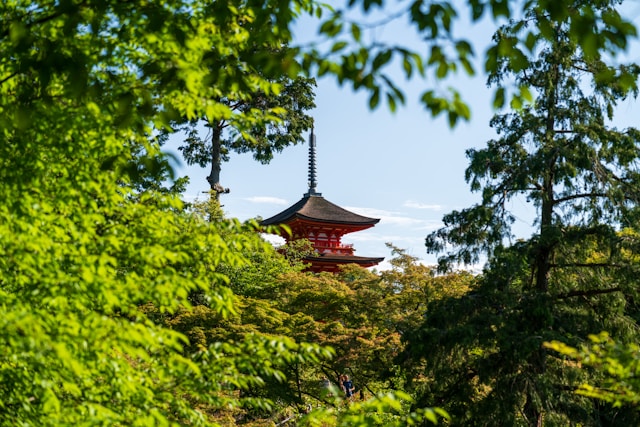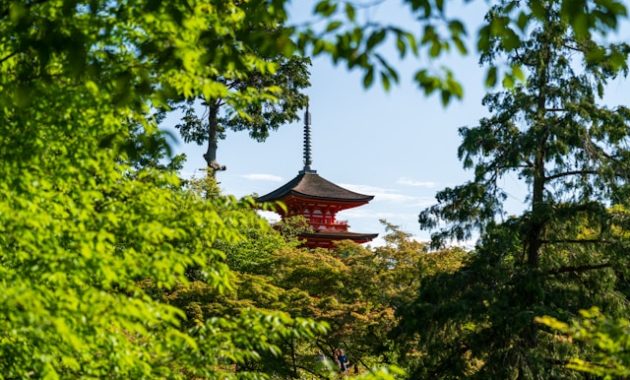
Kyoto, once the capital of Japan, is a city imbued with a profound spiritual heritage. With its timeless temples, ancient shrines, and serene Zen gardens, Kyoto is the epicenter of Japanese religious life. The centuries-old structures scattered across the city tell stories of Buddhism, Shintoism, and a dedication to preserving cultural identity. Embarking on a journey through these sacred places not only offers insights into Japan’s past but also a window into the country’s enduring spiritual traditions. In this article, we guide you through the most iconic temples in Kyoto, each a testament to the city’s rich spiritual and architectural legacy.
Kinkaku-ji: The Golden Pavilion
Among the most famous temples in Kyoto is Kinkaku-ji, or the Golden Pavilion. This breathtaking structure, covered in gold leaf, reflects majestically in the calm waters surrounding it. Originally built in the 14th century as a retirement villa for Shogun Ashikaga Yoshimitsu, Kinkaku-ji became a Zen Buddhist temple upon his death. Its striking architectural style—combining three distinct styles, Shinden, Samurai, and Zen—makes it a must-see.
The serene garden encircling the pavilion follows the Muromachi Period’s principle of integrating architecture with nature. Visitors can wander through the pathways, taking in the meticulously designed landscape that includes a pond, islands, and carefully placed stones, all symbolic of Buddhist teachings.
Fushimi Inari Taisha: A Thousand Torii Gates
Known for its iconic vermillion torii gates, Fushimi Inari Taisha is one of Kyoto’s most visually recognizable and spiritually significant shrines. Dedicated to Inari, the Shinto god of rice, fertility, and prosperity, this shrine is situated at the base of Mount Inari and offers a deeply symbolic pilgrimage through thousands of torii gates that wind up the mountain.
Walking through these gates is a spiritual journey, representing the passage from the mundane world to the sacred. The trek to the summit of Mount Inari offers not only a profound spiritual experience but also breathtaking views of Kyoto. Along the way, you’ll encounter smaller shrines, stone fox statues (the messengers of Inari), and prayer offerings, each telling its own piece of the shrine’s rich history.
Kiyomizu-dera: The Pure Water Temple

Perched on a hilltop, Kiyomizu-dera offers stunning views of Kyoto from its wooden platform. This temple, dedicated to the goddess Kannon, is famed for its connection to purification rituals and healing waters. The name Kiyomizu means “pure water,” deriving from the Otowa Waterfall that runs beneath the temple. Visitors are invited to drink from one of the three streams, each said to offer blessings of longevity, success in studies, and a fortunate love life.
Kiyomizu-dera is not only renowned for its impressive wooden stage, which was constructed without the use of nails, but also for its seasonal beauty. In spring, the temple is surrounded by cherry blossoms, while in autumn, vibrant red maple leaves frame the iconic structure, making it a popular spot for both spiritual pilgrimage and sightseeing.
Ryoan-ji: The Zen Rock Garden
For those seeking a moment of quiet reflection, Ryoan-ji offers a profound meditation experience through its minimalist Zen rock garden. The temple, founded in the late 15th century, is home to one of Japan’s most famous karesansui (dry landscape) gardens. The garden consists of 15 rocks carefully placed on a bed of white gravel, designed to evoke a sense of calm and contemplation.
Scholars and visitors alike have long speculated about the garden’s meaning, but the true beauty lies in its simplicity and the opportunity it provides for personal reflection. Whether the rocks symbolize islands floating in the sea, mountain peaks above clouds, or something entirely different, is left to the observer’s interpretation.
Ginkaku-ji: The Silver Pavilion
Though less opulent than its golden counterpart, Ginkaku-ji, or the Silver Pavilion, is no less significant in Kyoto’s temple landscape. Built as a retreat for Shogun Ashikaga Yoshimasa in the 15th century, Ginkaku-ji was intended to be adorned with silver leaf, though this plan was never completed. Nevertheless, the temple remains an embodiment of wabi-sabi, a Japanese aesthetic that finds beauty in imperfection and transience.
Surrounded by a serene moss garden and a unique sand garden representing waves and mountains, Ginkaku-ji offers a peaceful escape from the bustling city. Visitors can follow a walking path around the grounds, where each turn reveals a new perspective of the temple’s quiet elegance.
Tenryu-ji: A UNESCO World Heritage Site
Tenryu-ji, located in the Arashiyama district, is a UNESCO World Heritage Site and a prime example of Zen Buddhism. Founded in the 14th century, Tenryu-ji is revered for its Sogenchi Garden, a design attributed to the Zen master Muso Soseki. The garden’s layout, with its reflective pond and carefully composed elements, is meant to embody the essence of Zen philosophy, where harmony between nature and man is paramount.
A visit to Tenryu-ji is often combined with a stroll through the nearby Arashiyama Bamboo Grove, where towering bamboo stalks create a mesmerizing, otherworldly atmosphere. Together, the temple and its surrounding landscape offer a meditative retreat from the fast pace of modern life.
Sanjusangen-do: A Thousand-Armed Kannon
For those interested in Buddhist iconography, Sanjusangen-do is a must-visit. This temple houses 1,001 statues of the Kannon, the goddess of mercy, each meticulously crafted and displaying intricate details. The temple hall, which stretches 120 meters, is the longest wooden structure in Japan, and walking its length gives visitors a sense of awe at the artistry and devotion embodied in these statues.
The temple’s main deity, a large seated figure of Kannon, is said to have a thousand arms to help her reach out to those in need. The sheer number of statues and the grandeur of the hall create a powerful, almost overwhelming spiritual experience.
Nanzen-ji: A Gateway to Zen
Nanzen-ji, one of the most important Zen temples in Japan, serves as a gateway to understanding the principles of Zen Buddhism. Founded in the 13th century, this expansive temple complex includes a massive Sanmon gate, which offers panoramic views of Kyoto for those who climb to the top. The temple grounds also feature a beautiful Hojo garden, where the rocks and sand are arranged in patterns meant to inspire tranquility and meditation.
One of the unique features of Nanzen-ji is the aqueduct that runs through the temple grounds. Built during the Meiji period, this architectural marvel is a striking contrast to the ancient structures, yet it complements the peaceful atmosphere of the temple.
Conclusion
Kyoto’s temples offer more than just historical significance—they are living expressions of Japan’s spiritual traditions. From the golden splendor of Kinkaku-ji to the quiet reflection of Ryoan-ji’s Zen garden, these temples invite visitors to explore the profound connections between architecture, nature, and the human spirit. As you wander through Kyoto’s timeless temples, you’ll find not only an appreciation for Japan’s past but also a deeper connection to the spiritual heartof the country.